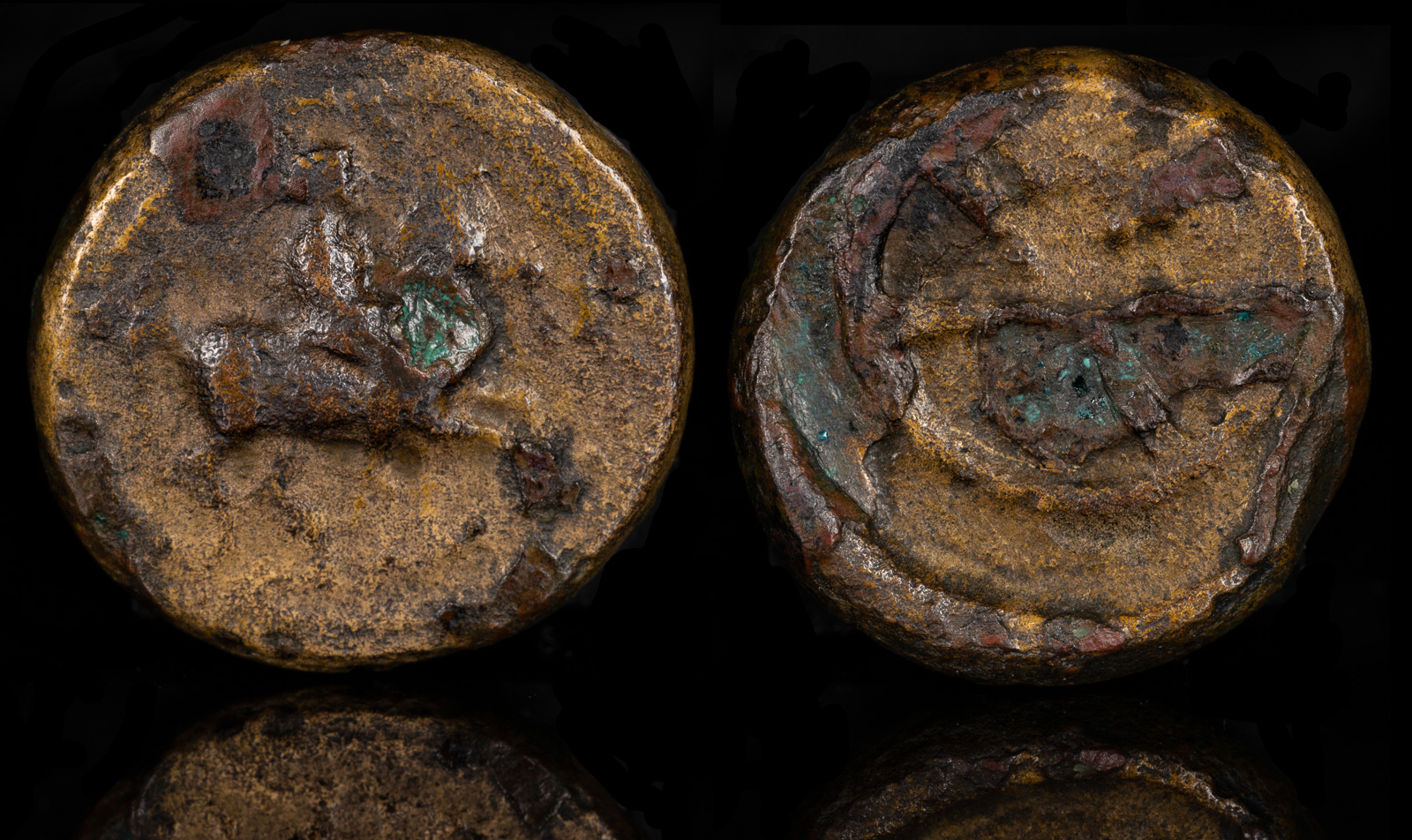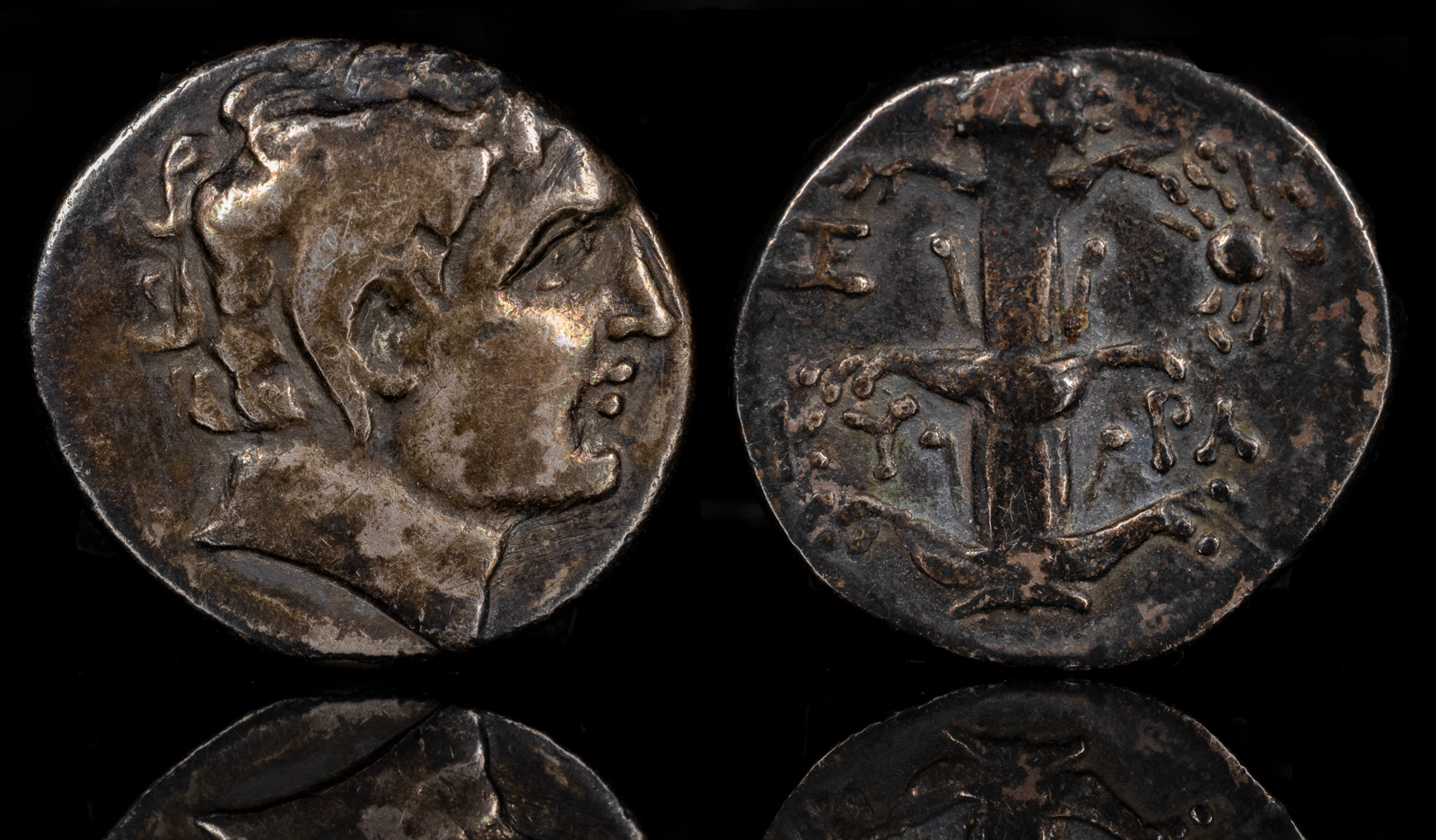
Kyrenaica. Kyrene. Ptolemaic Governor Ophellas First Reign
322-313 BCE
18.58mm 7.26 grams
Obverse: Youth on horseback right
Reverse: Wheel with four spokes and hub, silphium plant between left spokes
SNG Copenhagen 1221
Ex Marc Breitsprecher
Kyrene has a rather odd founding story. It was orignally settled by Grinos, king of Thera (now Santorini), who consulted the Oracle at Delphi on how to address a severe drought. The Oracle replied to found a new city in Libya.
However, Grinos wasn’t the smartest tool in the shed, so he went back to Thera because he didn’t understand the Oracle. The drought continued and he went back to the Oracle for advice, and was again told to found a city in Libya.
Grinos didn’t know where Libya is, so he found a guy on Crete who knew and they founded a colony on an island off the shore of Libya, but the drought continued. Again Grinos visited the Oracle and this time she said that he was a dumb-ass and she had specifically told him to create his city in Libya and not on an island off the coast. So, he finally obeyed her instructions, created a colony in Aziris, and six years later that colony was moved to the superior location of Kyrene, by which time the drought had ceased.
What I find far more fascinating about this coin is not the person, but what’s depicted. It’s an ancient plant called Silphium, which most believe is now extinct.

Kyrene, Magas
Ptolemaic governor, c. 300-282/75 BC
AR Didrachm 20mm, 7.30g, 12h
Head of Karneios r. R/ Silphion plant; ZE monogram to upper l., crab to upper r., KY-PA across lower field.
BMC 256; cf. SNG Copenhagen 1243
Easily the most valuable plant at the time, it transformed Kyrene from a backwater to one of the richest cities in the Mediterranean. The list of capabilities is impressive: a contraceptive and abortifacient. Cures a soar throat, fever, warts, and more. Used as a seasoning and perfume. When eaten by goats, it makes the meat incredibly tender.
What I wonder today is whether silphium was just a “craze”, akin to the Dutch tulip madness, or whether it was truly a remarkable weed. Sadly, it went extinct during the time of the 12 Caesars, so we’ll probably never know. Theories on its demise range from overgrazing to desertification to “it’s still around.”
So important was silphium to Kyrene’s economy (it only grew there), that many of its coins feature the plant. This one displays the stalk, bloom(?) at the top, and a crab.
My suspicion is the crabs had something important to do with the plant. Its seeds were supposedly shaped like hearts, and many believe the plant’s association with fertility and use as a contraceptive gave our current heart shape its form. My suspicion is silphium as a species no longer exists. Given that it was traded as far as India (and maybe beyond?), had it grown somewhere else, someone back then would have noticed. What I do wonder, though, is would our world be a bit different were it still to exist? Could it have cured cancer? Was it actually an effective contraceptive? Would our top steaks today involve silphium? Or, was the whole thing blown out of proportion?
Kyrene founded by settlers from Thera, with help from navigators at Itanos. Battos I becomes its first king.
Death of Battos I of Kyrene. His son Arkesilaos I becomes king and accomplishes nothing that we remember.
Death of Arkesilaos I of Kyrene. His son Battos II takes power who keeps the sovereignty of Kyrene over Egypt.
The indigenous Libyans ask Pharaoh Apries for help against the Greeks in Kyrene. He is defeated at the Battle of Irasa.
Death of Battos II of Kyrene. His son Arkesilaos II takes power and oversees the decline of the dynasty.
Arkesilaos II of Kyrene is strangled by his advisor Learchos, who is then killed when he returns to the city to become king. Battos III becomes king.
Battos III of Kyrene makes a pact with Pharaoh Amasis II. Amasis marries his daughter Ladike.
Death of Battos III of Kyrene, who with Demonax of Mantineia had reformed Kyrene’s constitution. Arkesilaos III becomes king.
Arkesilaos III of Kyrene makes a pact with Cambyses II of Persia.
Euhesperides founded by settlers most likely from Kyrene.
Arkesilaos III returns to Kyrene from Samos and is able to take the city. Fearing a backlash, he leaves to his father-in-law in Barka, where he is recognized by exiles and killed. His mother Pheretima takes over Kyrene.
Death of Pheretima, ruler of Kyrene. Battos IV, son of Arkesilaos III, takes over.
Death of Battos IV, king of Kyrene, which became a client kingdom of Persia during his reign. Leadership falls to his son, Arkesilaos IV.
Arkesilaos IV, king of Kyrene, wins a chariot race at the Pythian Games in Delphi.
Kyrene gives refuge to Athenian soldiers who had been defeated by the Persians in Egypt.
The unpopular Arkesilaos IV and his son are killed and beheaded by citizens of Kyrene, which ends the Battiad dynasty.
Spartan forces travelling to Sicily are taken by winds to Kyrene, who gives them ships to return.
Approximate year that Ariston takes control over Kyrene and kills 500 prominent citizens.
Messenians sent away from Naupaktos travel to Kyrene and join in the effort against Ariston, but most are killed.
Kyrene sends offers of friendship to Alexander the Great in Egypt, but do not come under Macedonian control.
326 BCE
The Spartan mercenary Thibron gathers exiles from Kyrene in Cretea and takes the city. However, one of his officers defects to the other side and he is ousted. Euhesperides supports him.
Thibron returns to Kyrene and takes it again.
Kyrene is considered part of the territory of Ptolemy I at the Treaty of Triparidisos.
Agathokles persuades Ophellas of Kyrene to join him as an ally against Carthage. Agathokles at first receives him warmly, then attacks his camp unexpectedly, kills Ophellas, and claims his troops.
Marriage of Demetrios Poliorketes to Eurydike, an Athenian noblewoman and the widow of Ophellas of Kyrene.
Kyrene ousts the garrison of Ptolemy I.
Magas refuses to submit to Ptolemy II Philadelphos and declares himself king of Kyrene.
Death of Magas, king of Kyrene. His wife Apama takes over.
Berenike II marries Ptolemy III, bringing control of Kyrene back to the Ptolemies.
Kyrene is established as a separate kingdom by Ptolemy VIII after he is banished.
Kyrene becomes part of the Roman Empire.
Kyrene receives its first Roman governor, Publius Cornelius Lentulus Marcellinus.
A massive Jewish revolt breaks out in Kyrene. Nearly all of the city’s buildings are destroyed.
Hadrian visits Kyrene.
Much of Kyrene is destroyed by an earthquake.
July 21
An earthquake destroys Aptera, Gortyna, Eleutherna, and Knossos on Crete. Alexandria is devastated by a tsunami, and Kyrene is also affected by the same tsunami. Kydonia is also damaged. In the Peloponnese, Messene is affected.